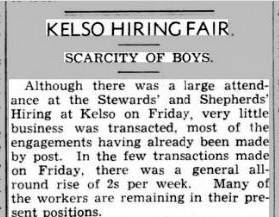Browsing through old newspapers makes fascinating reading with snippets of information on life in the past. Here are three entries on long—living Earlston residents, at a time when in 1901 the average life expectancy was only 45 years for men and 50 for women.
Southern Reporter: 22nd March 1888
So Janet Brown, nee Gray was born c.1798 She was 11 years old when King George III marked his jubilee in 1809, at a time when Britain was still fighting the Napoleonic Wars.
In June 1887 Janet was driven by Colonel Hope of Cowdenknowes in a pony and trap to the summit of the Black Hill to light the bonfire which blazed that night, like many around the Borders, to celebrate the Jubilee of Queen Victoria's reign.
Her brother Thomas Gray, besides being a bibliophile and antiquarian was the last gingham manufacturer in Earlston. He kept two looms in operation constantly and travelled across Southern Scotland to sell the "far famed Earlston ginghams". He died aged 88 on 15th January 1884 at Salt Green, Eyemouth, following a fall near the harbour.
Thomas Gray. of Earlston, (c.1796-1888) was known in his day variously as "Gingham Tam", "Tam of Earlston", "Earlstoun Tommy", and "A Modern Thomas of Ercildoune".
*************
"An Earlston Nonagenarian" was the headline in "The Southern Reporter": 29th October 1931 which reported on Janet Brown's niece Mary Thompson, nee Brown who was equally long living, with the newspaper giving a detailed obituary on her life and Border connections.
Mary was born 12th March 1836, (a year before Queen Victoria ascended the throne), and lived through the reign of four monarchs. Her father and grandfather, both called James Brown, were handloom gingham weavers when "those beautiful fabrics remained for over a century in fashion, displaced by cheaper print fabrics."
Mary's husband had worked as a groom for Mr. Morkle who laid the Berwickshire Railway to Earlston in 1862 and was for many years employed at Brownlie's timber merchants. The family lived in the cottage near the railway crossing on the road to Georgefield.


*************
"An Instance being Fruitful and Multiplying" was the intriguing headline in The Berwickshire News and General Advertiser: 17th May 1881 which reported:"There died the other day at East Morriston a man named John Middlemass, at the very advanced age of 93. He was the father of 11 children. He had 70 grandchildren, 138 great-grandchildren, and 4 great, great grandchildren , making in all 223 descendants."
So John Middlemass must have been born c.1788, just before the time of the French Revolution, and 75 years before the railway reached Earlston in 1863.
************
DEATH OF LANCELOT WATSON: 11th April 1918 - Hawick Advertiser.
But who was Lancelot Watson, with Earlston, Hawick and American connections?
More research called for here!
More research called for here!
************
Source
Have you come across snippets of Earlston News in old newspapers?
If so do let us know by e-mailing: auldearlston@aol.com
THANK YOU





































